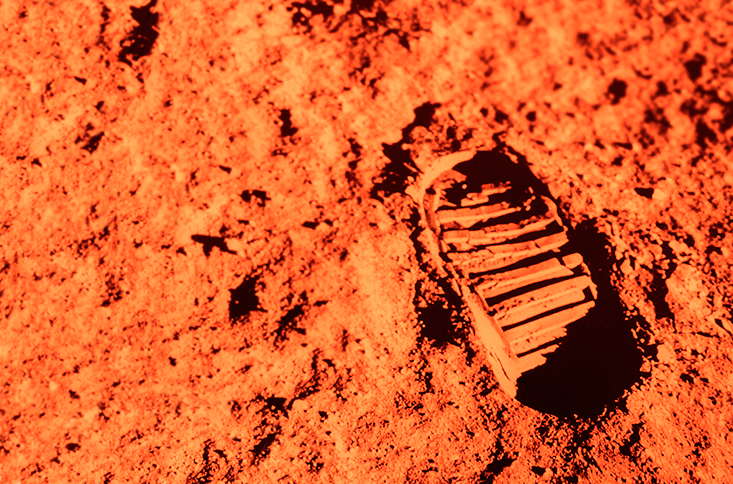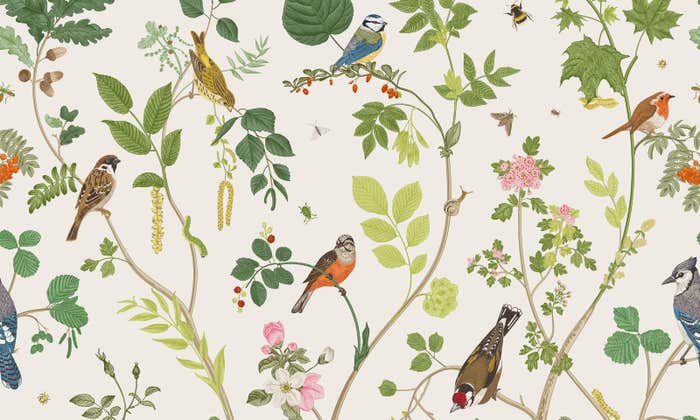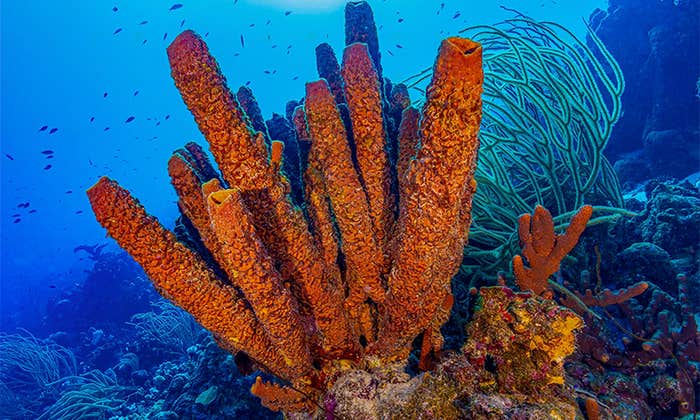In the upcoming Hollywood movie, The Space Between Us, a child is born to an American astronaut on Mars. The mother dies in childbirth, but the baby survives, and is raised by a small colony of astronauts on Mars. In the trailer, a somber voice-over intones the central conceit of the film: “His heart will simply not have the strength for the Earth’s gravity; his bones will be too brittle.” In other words, there is no turning back. It’s a question worth pondering—if we choose to leave Earth, will our descendants ever be able to return?
We’re moving ever closer to Mars. NASA hopes to put humans on the red planet in 30 years, Elon Musk in 10—first perhaps, just to visit, but eventually, to create self-sustaining Martian cities. In a September 2016 speech, Musk cited the “two fundamental paths” humanity might take: “One path is that we stay on Earth forever and then there will be some eventual extinction event. The alternative is to become a spacefaring civilization, and a multi-planet species.”
If and when we do reach Mars, the conditions will be unlike anything on Earth. Adjusting to the weaker gravity, intense radiation, and a total lack of microbial life would cause generations of Martian colonists to undergo some of the most dramatic evolutionary changes in the human lineage since we started walking upright and developed our oversized brains.

The first evolutionary changes might be quick and subtle. Because the number of initial colonists would inevitably be small—Musk’s proposed spaceship would carry 100 people—the Martian colonists would experience a phenomenon known as the founder effect. The founder effect occurs any time a new environment, like a volcanic island freshly burst forth from the ocean, is colonized by new arrivals. The few individuals that establish themselves in the new place, however they got there, are not likely to be representative of the larger population from which they came. The smaller the sample, the less likely it is to represent the larger group from which it comes.
If we sent 100 colonists to Mars, the chances that they would accurately represent all humans on Earth in terms of height, hair color, propensity to develop diabetes or breast cancer, ability to wiggle their ears, or any number of other genetic factors, is extremely low. Whatever traits happen to be present in the original colonists would be passed on to their children and so, even without natural selection, the growing Martian colony would become somewhat distinct from the people back on Earth. So, for example, if all the astronauts we sent to Mars were redheaded, Mars would be the red planet in more ways than one.
Immune-compromised Martians would face life-threatening illness if they were to return to Earth.
The founder effect is, of course, not unique to Mars or interplanetary travel. It could happen in any isolated or selective population. But as the generations on Mars accrued, more pronounced and distinctive changes could take place. With just one-third the gravity of Earth, pregnancy and childbirth might be much more difficult on Mars. A study on embryonic development in mice found that fewer mouse mothers gave birth to live pups from embryos formed under simulated microgravity than at normal gravity.1 Interestingly, fertilization—performed in vitro—did not appear to be affected by decreased gravity, but some of the resulting embryos did not develop as well as embryos created under normal gravity. The reasons for this are not yet clear but the results suggest that mammals, including humans, might experience more complications during pregnancy on Mars than on Earth. This would have the potential to present a new evolutionary selection pressure not found on Earth.
The low gravity would also cause bone mass to decline at a rate of about 1 to 2 percent per month.2 Settlers might lose half of their bone mass after two or three years—perhaps even faster for pregnant women, since gestation requires large amounts of calcium. Bone density loss makes people more prone to injuries, especially fractures of the hip and spine. Because such injuries could be devastating on Mars, people who naturally have higher bone density—more similar to ancestral humans than to modern humans—might be more likely to survive and pass on their genes. Therefore, after many generations, Martian people could end up with naturally thicker bones than their forebears, lending them a more robust appearance.
Martian settlers will also need to adjust to high levels of radiation.3 Without a magnetosphere or atmosphere to protect it, Mars is bombarded by high-energy cosmic rays, intense ultraviolet radiation, and solar particles.4 After 500 days, a person on the surface of Mars would be exposed to a dose of radiation equivalent to six times the maximum annual amount allowed for employees of the United States Department of Energy. A limited amount of protection could come from spacesuits or from building living quarters underground, but doubtless some time would still need to be spent on Mars’s surface, growing crops, erecting buildings, and so on.
Radiation damages DNA, creating the sort of mutations that lead to cancer. While this might mean higher cancer rates for Martian settlers, it could also accelerate the evolutionary process by jump-starting the creation of random genetic variation, including traits that are beneficial in the Martian environment.5
Those genetic variations could include ways to protect our bodies from radiation damage. On Earth, our skin produces melanin, a pigment that acts as a natural sunscreen. Skin pigmentation has evolved in human populations in a balancing act between the danger of excess radiation, which disrupts the production of DNA, and the danger of too little radiation, which prevents bones from properly forming.6 Many other organisms use melanin to protect themselves from radiation, including dark colored fungi found growing at the site of the nuclear meltdown at Chernobyl. The form of melanin that provides the most protection from solar radiation in humans is eumelanin, which creates dark brown or black skin. Humans with much more eumelanin in their skin may better tolerate the extreme radiation on Mars, leading to Martians with darker skin than anyone on Earth.
On the other hand, the intense radiation on Mars might favor the evolution of new skin pigments. Carotenoids—the orange pigments that give carrots their color—are produced by many plants and microorganisms to protect against solar radiation. Although many animals have carotenoids, most get them from their diet. One exception is the pea aphid, a small insect that is usually green, but is in some cases red because of carotenoids it produces. Genome analyses revealed that pea aphids acquired the genes to make carotenoids from a fungus, suggesting that in rare circumstances animals can borrow the machinery for pigment production from other organisms.7 The harsh conditions on Mars might make such unlikely events more probable if the outcome—say, bright orange skin—was very beneficial.
Recent studies suggest that high levels of radiation also affect the brain, altering spatial memory and risk-taking behavior of some, but not all, mice and rats. Such impairments could pose a serious threat to the success of a Martian colony. Yet if the same variation in sensitivity to radiation seen in rodents exists among humans settling on Mars, natural selection would favor those individuals who are less affected. Later generations could evolve resistance to the harmful effects of radiation on the brain, making them better adapted to the Martian environment and more capable of further space exploration, perhaps even to more distant habitable planets like Proxima b.

Then there’s the microbiome—bacteria and other tiny organisms that grow in and on our bodies and profoundly affect us. These microbes are acquired throughout our lives, beginning with those that we pick up from our mothers during birth. Early childhood is an important time for developing a healthy microbiome, as children acquire additional microbes from their parents, siblings, friends, and environment. Children on Mars would not be exposed to the full plethora of microbes found here on Earth, and while scientists still hope to find microbial life on Mars, there’s still no firm evidence it exists.
The loss of beneficial microbes could lead to adverse physical and mental health outcomes for Martian settlers. Here on Earth, we’ve already seen a decline in microbial diversity in the microbiomes of people living in urban environments, where we do our best to sterilize our bodies and our environments to prevent the exchange of disease.8 In many ways this has been a good thing—once-common diseases like smallpox have been eliminated thanks to the development of vaccines, and improvements in sanitation and the availability of antibiotics have confined other diseases to particular regions. But an unintended consequence of our war on microbes has been the persecution of microbial species that are beneficial to our health, including some that have been with us for millennia and are now threatened with extinction.
Mars might be a step too far for these microbes, and losing them altogether would almost certainly be detrimental. People with low diversity in their microbiomes are more likely to develop obesity, Type I diabetes, and possibly other conditions, including allergies, asthma, Celiac disease, and certain cancers.9 Experiments in which mice and rabbits are raised in sterile environments that prevent them from developing any microbiome at all provide a grim outlook.10 Their immune and nervous systems do not develop properly, and their ability to recover nutrients from their food becomes compromised.
Settling Mars could eventually lead to the evolution of an entirely new human species.
The microbes that live in our guts play important roles in digestion, so the diets of Martian settlers will need to be modified if their microbiomes are entirely lost. Scientists could create specifically engineered foods that include only simple sugars, proteins, and fats so that they are easier to digest without microbial assistance. On the other hand, should some beneficial microbes accompany us to Mars, the microbes themselves may evolve along with us. Because of their short generation times—some bacterial species reproduce every 30 minutes—microbes evolve much faster than humans, allowing them to adapt quickly to changing environments. Radiation would affect them, too, increasing their mutation rate and further accelerating their evolution.
The same processes would happen to any plants or animals we brought along with us, and to the microbes living in and on these species. In other words, establishing a Martian colony would sow the seeds of new type of ecosystem. Terraforming Mars—deliberately altering the Martian environment to make it more Earth-like—could lead to the evolution of ecosystems unlike anything we have on Earth.
The good news is that infectious diseases might not be a problem on Mars. As is true for our microbiome, the only viruses, pathogenic bacteria, and other disease-causing microorganisms would likely be the ones we bring with us. The long trip from Earth to Mars could serve as a quarantine, limiting the chances of accidentally introducing an infectious disease to Mars. The majority of infectious diseases that affect humans are the result of infections we acquired from animals, particularly birds and mammals.11 Many, like anthrax and rabies, come from domestic animals like sheep, cattle, and dogs. Others, like Lyme disease, largely come from wild animals. On Earth we are constantly faced with new diseases, like Ebola and Zika, in part because these microbes regularly jump from infecting animals to infecting humans. We could avoid this problem on Mars by not bringing any birds or mammals, opting instead for insect livestock, which are less likely to carry infections that can jump to human hosts (and require less feed).
On the other hand, living without the threat of infectious disease could cause the immune system of Martian colonists to atrophy, becoming a vestige like the appendix, or perhaps disappearing entirely. This atrophy could be driven by more than the lack of disease: Astronauts often experience immune system suppression12 during spaceflight, which has largely been attributed to the stress of takeoff and landing and of being in a confined space, but some evidence suggests that microgravity plays a role as well.13
Immune-compromised Martians would face life-threatening illness if they were to return to Earth, and people from Earth would risk wiping out the entire Martian colony if they brought any diseases with them. The risks associated with carrying a disease without showing symptoms, as commonly happens with sexually transmitted infections such as HIV or chlamydia, would be great. Close personal contact—like sex—between Earthlings and Martians would be very risky.
Take this all together—no sex between Earthlings and Martians, founder effects, changes to the microbiome, natural selection in the harsh Martian environment, and low gravity—and the message is clear: Settling Mars could eventually lead to the evolution of an entirely new human species. This happens routinely to animals and plants isolated on islands—think of Darwin’s famous finches. But while speciation on islands can take thousands of years, the accelerated mutation rate on Mars and the stark contrasts between conditions on Mars and Earth, would likely speed up the process. In just a few hundred generations—perhaps as little as 6,000 years—a new type of human might emerge.
In 1950, Ray Bradbury published a series of linked short stories called “The Martian Chronicles” that imagined a distant future in which Mars had been long ago colonized by humans, who have subsequently lost all interest in and connection to Earth. The Martians have brown skin and yellow eyes. “Do you ever wonder if—well, if there are people living on the third planet?” asks one Martian. “The third planet is incapable of supporting life,” states her husband. “Our scientists have said there’s far too much oxygen in their atmosphere.”
Bradbury’s fiction may well prove prescient. Should some disaster occur on Earth, colonizing Mars might be necessary for our long-term survival. Yet the strategy meant to preserve our species might ultimately change us forever.
Scott Solomon is a biologist and science writer based in Houston. He teaches ecology, evolutionary biology, and scientific communication at Rice University where he is a professor in the department of BioSciences. His first book, Future Humans: Inside the Science of Our Continuing Evolution, was published on Oct. 25, 2016 by Yale University Press.
References
1. Wakayama, S., et al. detrimental effects of microgravity on mouse preimplantation development in vitro. PLoS ONE 4, e6753 (2009).
2. Holick, M.F. Microgravity-induced bone loss—will it limit human space exploration? The Lancet 355, 1569–1570 (2000).
3. Ohnishi, K. & Ohnishi, T. The biological effects of space radiation during long stays in space. Biological Sciences in Space 18, 201–205 (2004).
4. Hassler, D.M., et al. Mars’ surface radiation environment measured with the Mars science laboratory’s Curiosity rover. Science 343, 1244797-1–1244797-6 (2014).
5. Kondrashov, A. Genetics: The rate of human mutation. Nature 488, 467–468 (2012).
6. Jablonski, N.G. & Chaplin, G. The evolution of human skin coloration. Journal of Human Evolution 39, 57-106 (2000).
7. Moran, N.A. & Jarvik. T. Lateral transfer of genes from fungi underlies carotenoid production in aphids. Science 328, 624-627 (2010).
8. Carlotta De Filippo, C., et al. Impact of diet in shaping gut microbiota revealed by a comparative study in children from Europe and rural Africa. Proceedings of the National Academy of Sciences 107, 14691–14696 (2010).
9. Blaser, M.J. Missing Microbes: How the Overuse of Antibiotics Is Fueling Our Modern Plagues Henry Holt & Co., New York, NY (2014).
10. Williams, S.C.P. Gnotobiotics. Proceedings of the National Academy of Sciences 111, 1661 (2014).
11. Quammen, D. Spillover: Animal Infections and the Next Human Pandemic W.W. Norton & Company, New York, NY (2012).
12. Dunn, A. & Abadie, L. Study Reveals Immune System Is Dazed and Confused During Spaceflight. www.nasa.gov. (2014).
13. Borchers, A.T., Keen, C.L., & Gershwin, M.E. Microgravity and immune responsiveness: implications for space travel. Nutrition 18, 889-898 (2002).
Photo collage credit: Image Source / Getty Images; Wikipedia


























